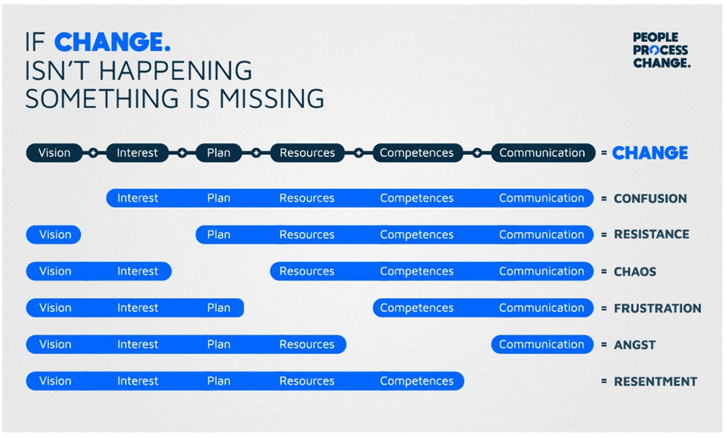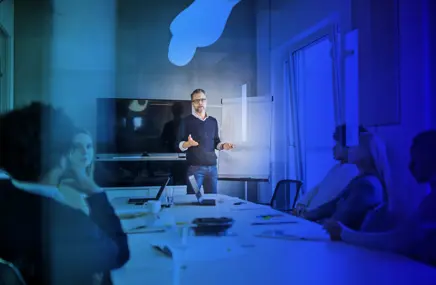Cloud onboarding: Preparing for change
Critical steps to iManage Success
As you plan your iManage implementation, keep this in mind: Deploying our platform — the technology — is the easy part, relative to the people part. Many studies, some from the world’s top consulting companies, have shown that major technology deployments can fall short of delivering their expected outcomes because organizational change management was neglected.
The illustration below depicts the Lippitt-Knoster Model for Managing Complex Change. If any of its six areas are not addressed sufficiently, the organizational result at the right could potentially occur.

Training is not sufficient to ensure technology adoption
Because organization cultures can vary considerably, a change management program is needed to ensure your people will accept the transformative change that iManage can bring them. Employee resistance can slow adoption, utilization, and ultimately, your return on investment. That’s why you need to prepare your people for change if you haven’t started doing so already.
Your goal should be that when Launch time comes and your users are trained to change how they work, they will value their new tools and capabilities enough to adopt and use them confidently until they become second nature.
Training is important, to be sure, but it is not organization change management. After all, high rates of a technology’s adoption and utilization require not just the know-how that training provides but also the enthusiastic acceptance of the tools by users.
That’s when your organization’s ROI will really start kicking in. That’s when your users will start making knowledge work better for them as individuals and for the company, with better business outcomes.
A discipline necessary for organizational transformation
What is change management? We think one of the best definitions comes from Prosci, a consulting group founded in 1994 that focuses exclusively on helping clients put its research and best practices to work:
Change management is the discipline that guides how we prepare, equip and support individuals to successfully adopt change in order to drive organizational success and outcomes.
Done well, change management results in an aligned and sustained shift in organizational behaviors. In fact, Prosci’s research shows that projects using what it considers best practices in change management are six times more likely to achieve their goals than those with poor change management programs.
To get there, leaders of change initiatives within organizations, whether top executives or heads of major transformation projects, must plan carefully to communicate the reasons for change, who’s responsible, how it will affect workflows and individuals’ jobs, and what benefits and results are expected.
In our experience, an effective change management program to support technology adoption can be done in-house or with outside consultants. Either way, it’s as essential to success as the proper deployment of your iManage technology. And however it’s done, preparing your organization for change should include the following dimensions:
Preparing your organization for change
Top leadership’s visible support
As we suggested in iManage Success: Three Key Factors, it’s a good idea to have the highest-level person on your leadership team play the role of executive sponsor, serving as the team’s internal spokesperson and face of the project.
Candidates for this role would be the managing partner at a law firm, the head of legal operations in a corporate law department, or the CIO at a professional firm or enterprise. This person will facilitate the team’s education in the project’s “why” and “how” as well as deliver key messages and updates on progress.

Buy-in from stakeholder leaders
You’ll need support from the line executives for key stakeholder groups and from their middle managers and front-line supervisors. The initial meeting with each person will be a bit of a sales call to explain the need for change and its value, discuss how the change will affect the group, and explicitly ask for their support.
If your implementation team needs a representative, ask for that person’s name and a separate meeting with both together to discuss what their commitment will involve and require. You should schedule periodic meetings to keep them informed of your organization’s iManage implementation milestones and solicit their input and feedback for the Design stage.

Message development
Consistent messaging about the coming change is needed and should be documented for the entire organization. It should then be tailored for stakeholder groups by taking time to brainstorm a “persona” profile for each group that includes their pain points, what they know (and may fear) about possible remedies, and the best ways to communicate with them.
To this last point, communications and training professionals know the acronym WIIFM — “What’s in it for me?” — as the key to capturing an audience’s attention and their support for what’s being said and taught.
Groups need messaging that answers WIIFM directly and does so in engaging and compelling ways. Good storytelling, role-playing, short pop quizzes, good graphics, and other techniques can all help. Be sure to ask for input and feedback at every point of contact.

Communication planning
Once you’ve developed a set of documented messages and have tailored them for your different stakeholder groups, you should plan to communicate them effectively. Put dates on a calendar, checking with your executive sponsor’s availability for in-person meetings like town halls and perhaps schedule a series of “lunch and learn” sessions. (Employees love food!) Include your messages in internal newsletters, posters, and any other media available to you. If you have an internal communications person available, contact them early for advice and help.

Training development
Before anyone can benefit from iManage, they need to learn how to use its tools. Work with your HR team’s training professional, your implementation partner, and your iManage Success Team to develop an effective user-training program.
Plan for stakeholder groups to train together as much as their schedules allow. This way, you or whoever’s leading the training can take the opportunity to frame it with the group’s tailored messages as well as get group feedback on how well the iManage tools are working for them and what could be improved.

Input and feedback
We can’t emphasize enough how important it is to get input and feedback from your stakeholder groups. Even before training, it’s a good idea to host focus groups — without discussing technology at all — to discuss their productivity, collaboration, and workflow issues.
These meetings can serve as starting points for gathering requirements for the Design stage of your iManage implementation path. Be sure to document what’s said in each meeting, and then point out the features and capabilities that their input helped to shape, so they know they were heard and their input is valued.
In many cases, the features and capabilities would already have been part of your planned iManage configuration. However, by showing a group how those reflect its needs and can be used to address them, you will have taken another big step in winning them over to quick adoption and full utilization.

Ready to assist in your change management
Preparing for change via a disciplined change management approach is well worth the time and effort it takes to do it well by following best practices. As mentioned, doing so can increase the chances of reaching your goals of a successful iManage adoption and utilization by six times compared to doing change management poorly.
Your implementation partner and iManage Customer Success team stand ready to assist in your change management based on our knowledge and experience. Whether you decide to do it in-house or invest in a consultant, we will be there for you and for your users to ensure that their successful adoption of iManage is rapid and sustained.
Making Knowledge Work
Request a demo
Ready to see how iManage can make a difference to your organization?
